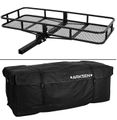Cargo carrier
Abstract
A child with Cerebral Palsy has a collapsible wheelchair that must be stored and transported with her when traveling by vehicle. Additionally, this child has recently been diagnosed with Epilepsy, and a large amount of emergency medical equipment must be transported with her everywhere she goes. Included is an oxygen supply, medical care kit, and hospital stay equipment in addition to a wheelchair.
Team members
- Zachary Rollins
- Nathan Jenkins
- Jeremy Puhr
- Eddie Gaspar
Problem Statement/overview of the need
In case of a medical emergency, equipment and supplies must be kept on hand as well as hospital over night stay materials. In addition to normal travel, during which a wheelchair must also be stored, long distance drives must be taken to keep appointments. The vehicle currently used by the foster parent does not have room for all equipment that must be kept at hand at all times, and so a large, water-proof container that can be locked up and fits in a receiver hitch is desired.
Design Specifications
- Dimensions of 5’ x 2’ x 2’
- Needs to be Waterproof
- Container itself need to be less than 100 lbs
- Needs to fit into receiver hitch of truck
- Should have spot for lock
- Potentially have a spot for a license plate
Background research
The hitch market is very wide with a large variety of products available including waterproof containers with locking capabilities. While racks of the desired size are available, lacking are containers with the exact dimensions needed, and the existing products exceed the cost we would like to remain under.
Conceptual Design
Summarize your conceptual design process. Develop at least three concepts.
Design Concept 1
Our First design is the most widely available "waterproof" cargo carrier on the market. The hitch cargo carrier is 60" x 24" with a 6" deep cargo well, which meets our major design parameters of being 5'x2' (ie 60"x24"). The carrier does come with a water resistant cargo bag, which does not meet our 24" deep parameter. This design is also missing the security and vehicle legality measures the family has asked for.
This carrier will excel in weight to strength ratio (Weight=16 lbs & Max Load=500lbs). However, it does not meet the requirements for security, and storage space!!
Design Concept 2
Design 2's carrier will be on that the team builds. We plan to build the frame out of 2"x2" angle iron that is 1/8" think. We then plan to make a base out of 1/2" metal mesh, and plan to use a 2"x2" Steel Square tube that is 1/4" thick for our piece that will go into the truck's hitch.
The water-proof box will be made of a 3/16 sheet of HDPE smooth SR sheet. HDPE provides great impact resistance and can withstand the elements. The box will have 5 sheets of HDPE(Bottom, Front, Back, Left, and Right) and a lid that resembles a Yeti-Cooler's lid. The lid will have a groove hollowed out in which a rubber seal will glued in, so that the top edge of the walls are firmly pushed into the seal once the lid is closed. The lid and front of the box will also have a latch so the family can secure the medical equipment.
The carrier only once constructed will weigh in the area of 30 - 40 lbs and the metal only will cost roughly $300 plus shipping. The HDPE box will be roughly 45 - 55 lbs once the hardware and every thing is added, and will cost roughly $100. For a GRAND WEIGHT OF ~95lbs.
Design Concept 3
Design 3's carrier is the carrier from design 1. We made this choice because of the overall design and function of a bought cargo carrier. The carrier will provide the needed 60"x24" cargo space at a fraction of the weight and half the price of a team built carrier.
The water-proof box to be installed on the carrier is the same box design from 'Design Concept 2'.
We as a team are wanting to provide the family with a strong, water-proof cargo carrier that is relatively easy to remove and attach when the family needs it, so
The bought carrier is 16 lbs and has a max load of 500 lbs. The box will be roughly 45 - 55 lbs once the hardware and every thing is added, and will cost roughly $100. For a GRAND WEIGHT OF ~71 lbs!!
Evaluate concepts/select candidate
Use a decision matrix or similar tool to compare designs against project specifications Discuss winning candidate
Detailed Design
This section will describe a detailed design process
Description of selected design
Detailed description of selected design
Analysis
Describe three types of analysis to be performed on the design
Engineering analysis 1
Engineering analysis 2
Engineering analysis 3
CAD Drawings
Insert drawings of all parts and the assembly
Bill of Materials
qty, item, description, source, part number, price
Assembly Instructions
Fabrication Process
Insert pictures of fabrication process
Testing and implementation
Describe testing, delivery, how used/received by the family
Photos of Completed design
Insert pictures of the final product
Instructions for safe use
Provide a clear summary of safe use for the family. Do not use the device unless supervised by an adult that has been fully understood the safe use of this product.




